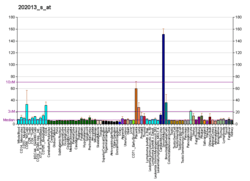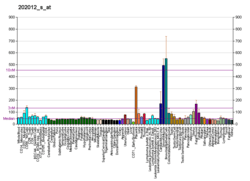EXT2 (gene)
Exostosin-2 is a protein that in humans is encoded by the EXT2 gene.[5][6][7]
This gene encodes one of two glycosyltransferases involved in the chain elongation step of heparan sulfate biosynthesis. Mutations in this gene cause the type II form of Multiple Exostoses.[7]
Interactions
References
- 1 2 3 GRCh38: Ensembl release 89: ENSG00000151348 - Ensembl, May 2017
- 1 2 3 GRCm38: Ensembl release 89: ENSMUSG00000027198 - Ensembl, May 2017
- ↑ "Human PubMed Reference:".
- ↑ "Mouse PubMed Reference:".
- ↑ Wu YQ, Heutink P, de Vries BB, Sandkuijl LA, van den Ouweland AM, Niermeijer MF, Galjaard H, Reyniers E, Willems PJ, Halley DJ (May 1994). "Assignment of a second locus for multiple exostoses to the pericentromeric region of chromosome 11". Hum Mol Genet. 3 (1): 167–71. doi:10.1093/hmg/3.1.167. PMID 8162019.
- ↑ Bridge JA, Nelson M, Orndal C, Bhatia P, Neff JR (May 1998). "Clonal karyotypic abnormalities of the hereditary multiple exostoses chromosomal loci 8q24.1 (EXT1) and 11p11-12 (EXT2) in patients with sporadic and hereditary osteochondromas". Cancer. 82 (9): 1657–63. doi:10.1002/(SICI)1097-0142(19980501)82:9<1657::AID-CNCR10>3.0.CO;2-3. PMID 9576285.
- 1 2 "Entrez Gene: EXT2 exostoses (multiple) 2".
- ↑ Simmons, A D; Musy M M; Lopes C S; Hwang L Y; Yang Y P; Lovett M (Nov 1999). "A direct interaction between EXT proteins and glycosyltransferases is defective in hereditary multiple exostoses". Hum. Mol. Genet. ENGLAND. 8 (12): 2155–64. doi:10.1093/hmg/8.12.2155. ISSN 0964-6906. PMID 10545594.
Further reading
- Wuyts W, Van Hul W (2000). "Molecular basis of multiple exostoses: mutations in the EXT1 and EXT2 genes". Hum. Mutat. 15 (3): 220–7. doi:10.1002/(SICI)1098-1004(200003)15:3<220::AID-HUMU2>3.0.CO;2-K. PMID 10679937.
- Wuyts W, Ramlakhan S, Van Hul W, et al. (1995). "Refinement of the Multiple Exostoses Locus (EXT2) to a 3-cM Interval on Chromosome 11". Am. J. Hum. Genet. 57 (2): 382–7. PMC 1801560. PMID 7668264.
- Stickens D, Clines G, Burbee D, et al. (1996). "The EXT2 multiple exostoses gene defines a family of putative tumour suppressor genes". Nat. Genet. 14 (1): 25–32. doi:10.1038/ng0996-25. PMID 8782816.
- Wuyts W, Van Hul W, Wauters J, et al. (1997). "Positional cloning of a gene involved in hereditary multiple exostoses". Hum. Mol. Genet. 5 (10): 1547–57. doi:10.1093/hmg/5.10.1547. PMID 8894688.
- Clines GA, Ashley JA, Shah S, Lovett M (1997). "The Structure of the Human Multiple Exostoses 2 Gene and Characterization of Homologs in Mouse and Caenorhabditis elegans". Genome Res. 7 (4): 359–67. doi:10.1101/gr.7.4.359. PMC 139145. PMID 9110175.
- Philippe C, Porter DE, Emerton ME, et al. (1997). "Mutation screening of the EXT1 and EXT2 genes in patients with hereditary multiple exostoses". Am. J. Hum. Genet. 61 (3): 520–8. doi:10.1086/515505. PMC 1715939. PMID 9326317.
- Wuyts W, Van Hul W, De Boulle K, et al. (1998). "Mutations in the EXT1 and EXT2 genes in hereditary multiple exostoses". Am. J. Hum. Genet. 62 (2): 346–54. doi:10.1086/301726. PMC 1376901. PMID 9463333.
- McCormick C, Leduc Y, Martindale D, et al. (1998). "The putative tumour suppressor EXT1 alters the expression of cell-surface heparan sulfate". Nat. Genet. 19 (2): 158–61. doi:10.1038/514. PMID 9620772.
- Lind T, Tufaro F, McCormick C, et al. (1998). "The putative tumor suppressors EXT1 and EXT2 are glycosyltransferases required for the biosynthesis of heparan sulfate". J. Biol. Chem. 273 (41): 26265–8. doi:10.1074/jbc.273.41.26265. PMID 9756849.
- Park KJ, Shin KH, Ku JL, et al. (1999). "Germline mutations in the EXT1 and EXT2 genes in Korean patients with hereditary multiple exostoses". J. Hum. Genet. 44 (4): 230–4. doi:10.1007/s100380050149. PMID 10429361.
- Xu L, Xia J, Jiang H, et al. (1999). "Mutation analysis of hereditary multiple exostoses in the Chinese". Hum. Genet. 105 (1–2): 45–50. doi:10.1007/s004390051062. PMID 10480354.
- Simmons AD, Musy MM, Lopes CS, et al. (1999). "A direct interaction between EXT proteins and glycosyltransferases is defective in hereditary multiple exostoses". Hum. Mol. Genet. 8 (12): 2155–64. doi:10.1093/hmg/8.12.2155. PMID 10545594.
- McCormick C, Duncan G, Goutsos KT, Tufaro F (2000). "The putative tumor suppressors EXT1 and EXT2 form a stable complex that accumulates in the Golgi apparatus and catalyzes the synthesis of heparan sulfate". Proc. Natl. Acad. Sci. U.S.A. 97 (2): 668–73. Bibcode:2000PNAS...97..668M. doi:10.1073/pnas.97.2.668. PMC 15388. PMID 10639137.
- Kobayashi S, Morimoto K, Shimizu T, et al. (2000). "Association of EXT1 and EXT2, hereditary multiple exostoses gene products, in Golgi apparatus". Biochem. Biophys. Res. Commun. 268 (3): 860–7. doi:10.1006/bbrc.2000.2219. PMID 10679296.
- Shi YR, Wu JY, Tsai FJ, et al. (2000). "An R223P mutation in EXT2 gene causes hereditary multiple exostoses". Hum. Mutat. 15 (4): 390–1. doi:10.1002/(SICI)1098-1004(200004)15:4<390::AID-HUMU35>3.0.CO;2-E. PMID 10738008.
- Stickens D, Brown D, Evans GA (2000). "EXT genes are differentially expressed in bone and cartilage during mouse embryogenesis". Dev. Dyn. 218 (3): 452–64. doi:10.1002/1097-0177(200007)218:3<452::AID-DVDY1000>3.0.CO;2-P. PMID 10878610.
- Bernard MA, Hall CE, Hogue DA, et al. (2001). "Diminished levels of the putative tumor suppressor proteins EXT1 and EXT2 in exostosis chondrocytes". Cell Motil. Cytoskeleton. 48 (2): 149–62. doi:10.1002/1097-0169(200102)48:2<149::AID-CM1005>3.0.CO;2-3. PMID 11169766.
External links
This article is issued from
Wikipedia.
The text is licensed under Creative Commons - Attribution - Sharealike.
Additional terms may apply for the media files.





